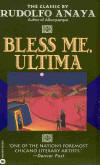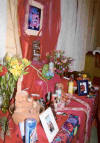
Curanderismo
is a traditional approach to healing used by many Mexican-Americans to
supplement Western conventional medicine. As discussed in Part 1,
curanderismo targets various categories of physical, emotional, or soul
dysfunction. A key type is susto (soul loss) caused by traumatic
events, ranging from the relatively minor, such as a marathoner spraining
an ankle, to the devastating, such as a woman getting raped.
Susto is
especially relevant for anyone disabled by accident or disease. Basically,
with susto, we become lose access to aspects of our higher self
needed for healing. Part 2 will provide an overview of key curanderismo
procedures, rituals, and ceremonies.
CURANDERISMO IN LITERATURE
A richer
appreciation for curanderismo and disability can be gained through readin g
contemporary Chicano literature. For example, author Rudolfo Anaya, who
was honored by President Bush with the 2002 National Medal of Arts
emphasized curanderismo in Bless Me, Ultima (1972). The Nation
magazine described this book as “the most important and influential
Chicano novel ever written.” The novel’s title character, Ultima, is a
wise curandera who nurtures a young boy’s soul in New Mexico in the 1940s.
g
contemporary Chicano literature. For example, author Rudolfo Anaya, who
was honored by President Bush with the 2002 National Medal of Arts
emphasized curanderismo in Bless Me, Ultima (1972). The Nation
magazine described this book as “the most important and influential
Chicano novel ever written.” The novel’s title character, Ultima, is a
wise curandera who nurtures a young boy’s soul in New Mexico in the 1940s.
Anaya’s
Tortuga (1979) is about a teenager nicknamed Tortuga (turtle) due to
his body cast. The book describes his survival and spiritual e volution
as he recovers from a spinal-cord injury (SCI) in a “crippled” children’s
hospital in the 1950s. Anaya based Tortuga on his own experiences
overcoming a paralyzing diving accident.
volution
as he recovers from a spinal-cord injury (SCI) in a “crippled” children’s
hospital in the 1950s. Anaya based Tortuga on his own experiences
overcoming a paralyzing diving accident.
In Shaman
Winter (1999), Anaya
created a neurologically compromised, wheelchair-using detective, Sonny
Baca, who relies on curanderismo for strength, healing and to combat the
evil brujo (witch) Raven.
Because curanderismo is grounded in spirituality, it
must be explained within that context, just as conventional medicine needs
to be discussed within a surgical and pharmaceutical framework. For
example, Baca’s never-ending conflict with the dark forces is reflective
of a core curanderismo belief that the universe’s duality-based energies -
such as good versus evil, male and female, physical and spiritual, etc –
all exist in sacred union as a part of God’s greater whole. In this
context, when one recognizes that they are a part of, and not distinct
from this oneness, they can access previously unavailable healing
energies. Given this belief, curanderismo prayers or chants are concluded
with the Nahuatl (Aztec) expression Ometeotl, meaning sacred union
of all.
CEREMONY
To further
understand curanderismo, I attended a workshop at Ghost Ranch retreat
center in a magnificent northern New Mexico setting where artist Georgia
O’Keefe did much of her painting. Led by curandera Elena Avila,
participants were mostly conventional healthcare professionals, including
some with disabilities, desiring to expand their healing insights.
Most curanderismo procedures are couched in a rich
ceremonial context that is virtually absent in Western medicine. According
to author Lewis Mehl-Madrona, MD, “at one time in their history, all
cultures have had beneficial healing ceremonies; unfortunately, most
modern, white-culture ceremonies have become so sterile they are not
conducive for healing.”
As a biochemist, I equate the ceremony to a chemical
catalyst. The difference is instead of accelerating the transition from
one chemical state to another, it catalyzes a shift to a more
health-enhancing consciousness.
Curanderismo ceremonies are characterized by prayers
and chants; the use of a resinous incense copal to cleanse or smudge toxic
energy from a healing environment; and ceremonial altars containing
symbolic sacred objects, such as candles with pictures of Saints (e.g.,
Virgin of Guadalupe, St. Anthony, etc). The altars are placed in the
primary compass directions, which have symbolic m eanings. The East
represents new beginnings; South, youth and intuition; West,
transformation (photo); and North, ancestral wisdom. Offerings are often placed on
these alters as symbolic food for the spirit world to enlist the help of
ancestors.
eanings. The East
represents new beginnings; South, youth and intuition; West,
transformation (photo); and North, ancestral wisdom. Offerings are often placed on
these alters as symbolic food for the spirit world to enlist the help of
ancestors.
PROCEDURES
In her book Woman Who Glows in the Dark,
(1999), Avila says “Curanderismo teaches that it is not enough to diagnose
a physical problem, as so many modern medical doctors do without looking
at what is going on in the heart and soul of the patient.” She emphasizes
that each patient has a unique story. Working with the patient, the
curandera facilitates the story’s revelation, which, in turn, opens a door
in consciousness that leads to healing at some level.
To open this door, the curandera uses a variety of
procedures or rituals, including
pláticas, limpias, and soul retrievals:
Pláticas are deep, nonjudgmental, often
multi-session, heart-to-heart talks between the curandera and patient in a
sacred environment of trust. Roughly comparable to psychoanalysis,
pláticas are tailored to the patient’s unique situation and use a
variety of mechanisms to help reveal the patient’s story, such as acting
out problems, dream interpretation, art therapy, or making masks. The goal
is to gain understanding and bring out suppressed beliefs that need to be
released to make room for new health- and life-renewing attitudes.
According to Avila, patients needs to desahogar, an “undrowning” to
get everything out of their heart.
Likewise, curandero David Young says pláticas
attempt to get patients “out of their heads into a process that moves them
past thinking into their hearts.”
To further develop their story, patients often place
personally relevant symbolic objects on the ceremonial altars. For
example, symbols of our past are placed in the North, such as photos of
deceased parents or children. In another example, the West is the
graveyard of our belief systems. It is where we let go of compromising
beliefs about, for instance, a failed marriage or career. It is also the
place where we release limiting attitudes about what may be possible,
accomplished, or achieved after disability. Avila simply calls it “energy
that doesn’t belong to us.”
This energy release is facilitated by limpias,
spiritual cleansings that can take a variety of ceremonial forms. These
often incorporate elements perceived as still possessing life-force
energy, such as raw fertile eggs, flowers, and fresh rosemary. As a crude
analogy, consider unwelcome beliefs as food particles stuck on a frying
pan (in other words our soul), and these living objects as the scouring
pad that will remove them when used within a spiritual context.
I have had several limpias. The first, run by
Young, used a sweat-lodge ceremony and ritually removed negative energy by
the brushing the body with cut flowers. At my Ghost Ranch limpia,
eggs (intact) and rosemary were rubbed over my body. In addition, Avila
swept an eagle feather around certain body areas in an effort to push out
the negative energies she perceived in my energy field. The egg, which had
absorbed my negative energy, was later ceremonially buried to be
transmuted by Mother Earth.
Finally, after the limpia-assisted release of
the negative beliefs, attitudes, and perceptions brought out by the
pláticas, a soul-retrieval ceremony reclaims aspects of
ourselves we have repressed through the susto created by life’s
trials and tribulations, such as injury, violation, or trauma. Through
this process, the curandera guides the patient back to balance, allowing
more full soul expression. Extensively discussed in Avila’s book, the
soul-retrieval can be mediated through many ceremonial mechanisms. For
example, if a woman was sexually abused as a child, a doll may be used a
symbolic representation of soul aspects lost by such abuse.
CONCLUSION
As a detached scientist merely desiring to learn more
about curanderismo, I initially viewed the incorporation of raw eggs and
rosemary in the Ghost-Ranch limpia ceremony as just quaint cultural
traditions As such, I was astonished by my limpia-induced
perceptual transformation. This transient perceptual state was one of my
most powerful life experiences.
As Shakespeare stated in Hamlet, “There are
more things in heaven and earth … than are dreamt of in your philosophy"
For me, curanderismo’s eggs and rosemary will forever be among them.
Adapted from article appearing in August 2006 Paraplegia News (For subscriptions,
call 602-224-0500) or go to
www.pn-magazine.com.
TOP